

 The South African
The South African
The background
St Helena Island is located in the South Atlantic Ocean, 1 950 km from the coast of Namibia. The nearest land is Ascension Island, which is 1 125 km to the north-west. The earliest Christian presence on the island was the Portuguese who landed there in 1502, followed by the English East India Company who built an Anglican Church in about 1674. The replacement is St James' Church built in 1774, the oldest Anglican church in the southern hemisphere. Jamestown, the capital, is named after King James II of England and is located in a long, narrow and steep valley.
The island is one of the most remote settled islands in the world. It measures 10.5 miles (16,9 km) long and 6.5 miles (10,5 km) across, with a total area of 47 square miles (122 km2). Between January and May 1673, the Dutch East India Company forcibly took the island, before it was reclaimed by English reinforcements. Since then it has been continuously inhabited under English/British rule.
The Anglo-Boer War, 1899 to 1902
During the Anglo-Boer War, the capture of Boer prisoners presented serious problems for the British authorities in South Africa. Even after their capture, the Boers could be relied upon to use any and every opportunity to escape and return to the conflict. They did not easily give up the fight. At some stage it was decided that the best way to subdue them was to send the captured Boers out of the country by sea. That would hopefully prevent them from returning to fight.
One of the biggest groups of prisoners was captured on 27 February 1900, when General Piet Cronje's commando surrendered to Lord Roberts' forces at Paardeberg. This group consisted of more than 4 000 Boers, including women. The men were sent to Green Point Camp, near Cape Town. From there they were moved to Simon's Town before embarking on several ships to St Helena Island, where they were interned until the end of the War.
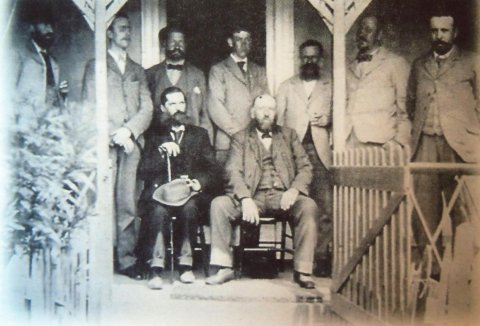
By December 1900, there were over 15 000 prisoners-of-war, most of whom were sent to camps in various parts of the British Empire, including Bermuda, Ceylon, India and St Helena. By the end of the War, there were almost 40 000 Boers held in these camps, who longed to be reunited with their families and hoped that their wives and children would survive the extreme conditions of the British concentration camps in South Africa.
Many of these men refused to let their circumstances prevail against their natural-born free spirit. They maintained a positive attitude and spent endless hours, weeks and months working on some creative activity. They built foot-driven lathes from basic components that had been begged, borrowed or stolen. They equipped themselves with elementary tools and fitted out basic workshops. Many Boers whittled away with pocket knives, carving many different items from wood and bone that they salvaged. Among the treasures that they fashioned were items of intricate jewellery, serviette rings, detailed chess sets, walking sticks, engraved boxes, and drinking cups used for 'Nagmaal' or communion services. Many of these historic items have become collectors' pieces and fetch high prices at auctions.
(With acknowledgements to the book, A Legacy Fulfilled, by Robert L Colville Smith, published by Just Done Productions, Westville, KwaZulu-Natal, pp 333-4).
The military history group
Members of the South African Military History Society were offered an exclusive discount by Mr Alan Foggitt, Managing Director of Starlight Cruises, to sail on the majestic MSC Sinfonia, visiting Walvis Bay and the historic St Helena Island during January 2013. The offer was advertised to all the major branches of the Society. Military History Society members who enjoyed the cruise were: Anthony and Letitia Coleman from Dundee, Alan and Christel Harvey from Stilbaai, Cape, Rex and Magda Hilligan from Johannesburg, Gil and Maeve Jacobs from Johannesburg, Mike and Sheila Johns from Johannesburg, Hennie and Je'anne Louw from Johannesburg, Neil and Mary MacDonald from Boksburg; Fred and Brenda Nel from Port Elizabeth, Bob and Joyce Smith from Johannesburg, and Richard and Jillian Tomlinson from Port Elizabeth.
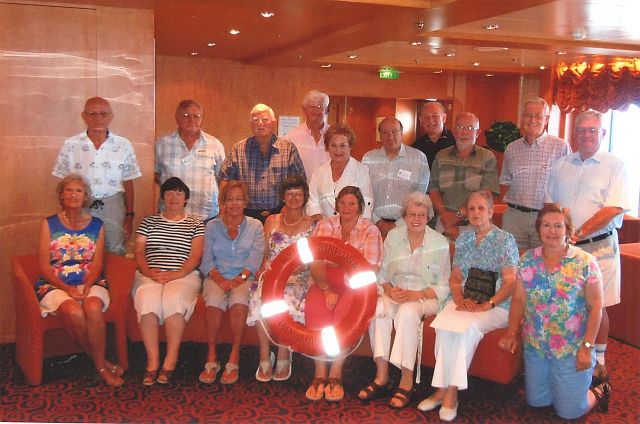
The cruise
There was an immediate positive interaction between the group members as they shared the same interests and their excitement at this rare opportunity. Sailing on the MSC Sinfonia was a wonderful experience and everyone was delighted with the comfort of the cabins and lounges. The beautiful swimming pools were inviting and the fitness-conscious were easily accommodated in the ship's well-equipped gymnasium that also offered great spa facilities. Every meal served in the dining room was a proverbial feast, and the group took turns to rotate between the two tables that had been especially booked for the group. A great variety of food choices were also available at the La Terrazza Buffet Restaurant on Deck 11, with its scenic views. The nightly performances at the Teatro San Carlo had everybody enthralled with world-class singers and dancers, and they surprised the audiences with breath-taking performances. The adventure-type tours that were offered at Walvis Bay were also enjoyed by many. Walvis Bay was an interesting destination bordered by desert sands, but boasting a massive harbour filled with hundreds of ships and cargo containers.
While at sea, a meeting was arranged with the Society members in the auditorium of the business lounge. Several short lectures were given on the highlights of St Helena Island. Visiting this historic island was the main reason for our history group, as well as most of the other passengers on board. It was fascinating to hear what they all expected to find on St Helena Island.
The Anglo-Boer War (1899-1902) was of prime interest to the members of our group and the link to the former Boer prisoner-of-war camps on St Helena Island was of personal nostalgic significance to those with relatives who had been banished there during the war.
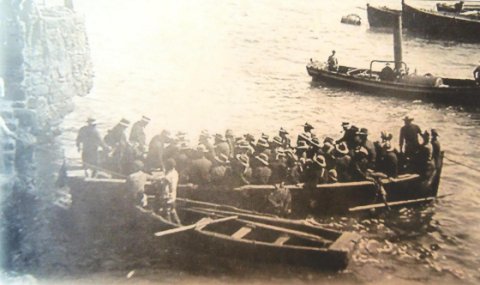
The cruise to the small island was smooth and some of the passengers saw dolphins and whales along the way, while I was fascinated by the 'flying fish' (family Excoetidae) that flew for about seven metres before diving back into the sea! I thought that they were birds at first!
The island
We anchored off St Helena early on Sunday, 20 January, but, due to heavy swells, the Captain decided that it would be too dangerous for the crew and passengers to attempt to land. This decision was not popular. Another attempt to land would be made on the following day.
Most of the passengers were ferried ashore on Monday, 21 January, despite the swells, which rose and fell by at least one metre. This meant that one had to take care in timing one's jump to the steps of the wharf. It did seem strange that, after seeing photographs of the landings of the Boer prisoners, and of the Royal Visit in 1947, the 'harbour' had not been significantly improved over several decades and it remained hazardous for the passengers of modern cruise liners.
On landing, we were met by Basil George of Magma Way Tours. He was a descendant of one of the Boers who had decided to remain on the island after the declaration of peace. Basil kept us very entertained with his vast knowledge of the background to many historical events that had taken place on this amazing island. He also answered at least one hundred questions!
Site of Deadwood Camp
The tour coach's first stop was at the site of the former 'Deadwood' Camp. Here, the association with the Boer prisoners was a touching experience for some whose relatives had been held there. The camp had been located on an unprotected sloping hill with frequent prevailing winds. It had been difficult for the Boer prisoners who had arrived there first in the early days, but soon, with their resolute determination, they had erected new structures, with shops, schools for the many youths under 20 years of age, churches and social halls. A new shanty town had emerged, named 'Blikjesdorp' ('tin town') and constructed from local timber, iron sheets and flattened paraffin and biscuit tins. There was even a 'Commissioner Street' in the town!
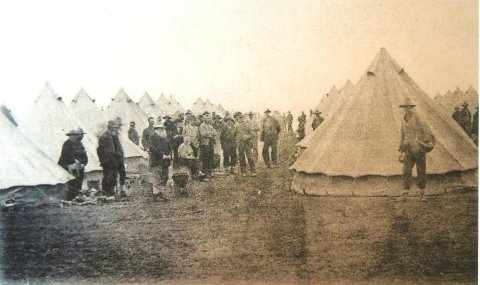
Many recreational activities were arranged to keep the morale high among the prisoners. There were various sporting activities that were physically challenging. Soon, another sport was also introduced, out of necessity. That was the' Sunday Flea Hunt', when everybody had to search their blankets for fleas and kill them as soon as they were discovered. Maybe there was a prize for the biggest pile of fleas?
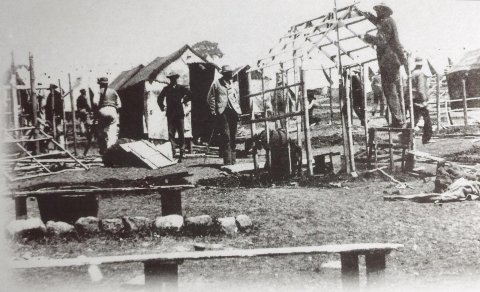
The Boers had great respect for their leaders and mostly abided by the decisions made that kept the camps under strict discipline. Several camp committees were established, including 'the Intellectual Group', comprised of Elders, Governors and the Judiciary. There was also a 'Grievance Committee' that was forever demanding absurd concessions for the prisoners. Generally, the prisoners were welltreated and many of the Boer shops were stocked with popular items from London. It seems that the Boers earned money by various means while on the island. I also saw a photograph of a building with a large fan outside. This was a workshop, turning out many amazing artefacts, and the fan powered a home-made lathe for turning wooden table legs and similar wooden articles. It reminded me of the slogan: "n Boer maak 'n plan!' ('A Boer makes a plan!').
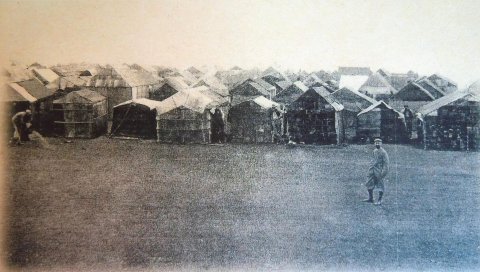
Longwood Residence
Nearby, we visited the famous 'Longwood' Residence that had been the home of Napoleon Bonaparte soon after he had been banished there by the British during October 1815. The museum was very stimulating and so well-preserved with furniture, photographs and many personal effects of Napoleon, that it seemed that he had only recently vacated the place. We were told how he enjoyed reading and had a special billiards' room, which he frequented. The bed on which he died during the evening of Saturday, 5 May 1821 is on display. His death mask provided authenticity of the famous man who had caused so much turmoil and death in Europe.
Napoleon had chosen a special place for his grave. He was buried in Geranium Valley, under the willow trees, adjacent to the spring from which he drank his daily water. He was buried with full military honours with a garrison of 3 000 soldiers lining the funeral route with their rifles held upside down. Due to a ridiculous dispute with the English governor, there was no inscription on his tomb. His remains were exhumed and taken back to France on board the French Frigate, La Belle-Paule, on 18 October 1840. He was finally laid to rest on 15 December in Les Invalides in Paris, where his crypt is still visited by millions of people.
The Boer Cemetery
While anchored off St Helena, we had all been disturbed by the volcanic-type rock that appeared to be so hostile and threatening to seafarers wanting to land. However, once in the centre of the island, we were surprised see the beautiful green countryside, reminiscent of the rolling hills of KwaZuluNatal. There were forests of great trees, including Yellow Wood plantations, with country churches and farming settlements with grazing cattle and goats. We visited the Boer Cemetery, where over 200 Boers were buried on very sloping ground. Two granite pillars record the name and age of every person buried there. It was sad to consider how far they had been taken to die, away from their own beloved country. Access to the cemetery entailed a long and tiring expedition from the Boer camps. The Anglican Church was much closer, but, because the Boers were considered to be enemies of the British Crown, they were not allowed to be buried in their consecrated cemetery. The Baptist Church, however, gave permission for the burial of Boers in their cemetery.
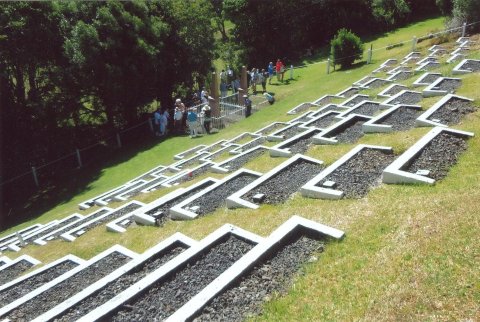
The site of Broad-Bottom Camp
The next prisoner-of-war site to be visited was Broad-Bottom Camp, which lay in a more hospitable valley with distant views of the sea. How often the camp residents must have scanned the horizon for a ship coming to take them home! Near to this site, there is a plan to build a 5-star hotel with a golf course, in conjunction with the airport which is being constructed by Basil Read pty (Ltd), South Africa. If completed according to the schedule, the airport could open in 2014, or later. How all these improvements will eventually affect the unique character of the island is a continuing debate among the 'Saints', as the islanders are affectionately named.
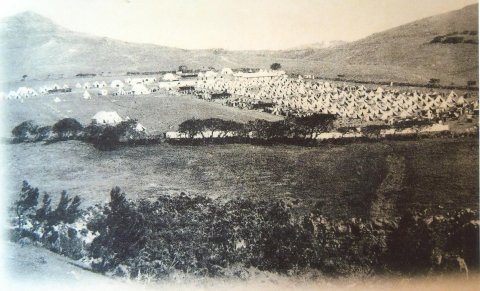
Other sites
We also visited the exterior grounds of Plantation House, where the Governor resides. The British Union Jack was fluttering from a flagpole, indicating his presence in the house. Although there were about 6 000 Boer prisoners on the island, they were not badly treated and it appears that only three were shot) for some serious crimes. At a distance, we saw another important resident of the island, Jonathan, the tortoise, who has lived there for almost 180 years and may be the oldest living creature on earth! He seemed to be taking a rest.
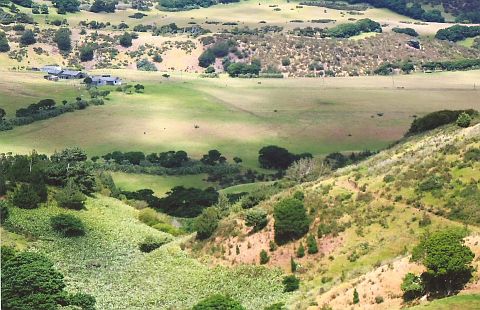
Due to time constraints, we left until last visiting the amazing 'Ladder Hill' with 699 steps, linking the town below to the Fort above. The bravest among us, Richard Tomlinson of Port Elizabeth, aged 77 years, decided to 'take the steps' and walk down to the city below! We had only a few minutes back in Jamestown before being ferried back to our ship, which was preparing to depart at 13h00. The city was fascinating, lying in a narrow valley with steep rock walls on either side. The buildings were of typical English-Georgian architecture. Most of all, we were charmed by the friendly disposition of the 'Saints', who were delighted to have so many visitors to their remote, but captivating island.
The reference above to Jamestown being a city is not incorrect. The story goes that the Anglican Church wanted to appoint a Bishop to their Jamestown church. He, however, wanted to be in charge of a cathedral, so they built him one as an additional church and then, true to effective British administration, raised the status of the town to that of a city so that they could boast of having their own cathedral!
The return cruise
After our visit to St Helena, we gathered again in the ship's auditorium to listen to many complimentary comments about our visit. In that short time, the 'Saints' had endeared themselves to everybody in our group and surely to all the other passengers who had gone ashore. When relating how they felt, there were many people with misty eyes! I awarded a unique 'Voyage of Discovery' Certificate to the couples from the military history group, who received them with great appreciation, referring to a cruise that would always be remembered!
The prospect of an eleven night cruise had put some people off joining the tour, but, speaking on behalf of most - if not all - the passengers, I will say that the time went very fast, especially with all the comforts on board MSC Sinfonia. After all the sumptuous food and the wonderful entertainment, we could hardly believe that we had arrived back in Cape Town so soon! Many of us could have carried on cruising for several more nights! We had all been deeply moved by the experience.
Return to Journal Index OR Society's Home page
South African Military History Society / scribe@samilitaryhistory.org